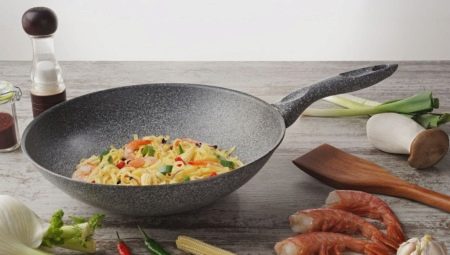Today on the Internet you can find a huge number of videos about cooking in Asia. Dishes resembling pancakes are prepared, as a rule, on round or rectangular plates without sides, but all other dishes are made in conical cauldrons, pans, pans - you won’t even realize what it is called. This is such an unusual dish for the European mentality that those who plan to master the preparation of Asian food should get to know this household utensil better.
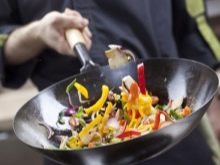
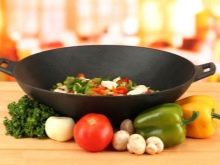
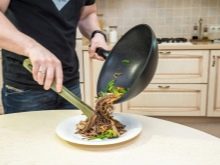
What it is?
A traditional eastern frying pan is called a wok. In the classic version, it has a rounded bottom, so you can’t put it on a flat surface. To answer the question why this dish looks so strange, you should turn to history.
China is considered the birthplace of wok, where fast-burning materials are still used as fuel: thin branches, straw, corncobs. And such "firewood" burns out so fast that you need to use iron utensils that quickly give their heat to products.
And this is how the wok appeared: the bottom heats up quickly, but the walls, which expand greatly to the top, remain only warm. And with constant stirring, the food manages to cook evenly in just a few minutes.
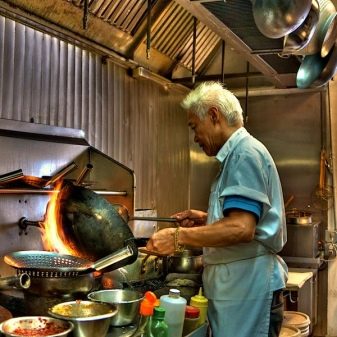
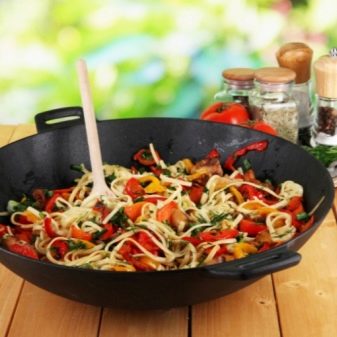
There are woks that prepare liquid dishes or are used as a double boiler. But they still differ from the usual frying pan (pan) with its greatly expanding neck. Modern manufacturers offer such dishes for use in homes, as well as over an open fire.A wok is available with one or two handles, which can be looped or long.
Today, wok is traditionally used in Asian countries. This kind of cauldron may be called in different ways. In India, for example, similar utensils are called karahas. But more and more fans of wok are found in European countries and on the American continents, because the pan is multifunctional, and food is more healthy for the health due to the speed of cooking.
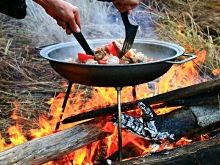


What is a pan for?
Wok is so versatile what can be in it:
- fry meat, vegetables, fish, nuts, cereals without oil, with the addition of oil or in deep fat;
- stew dishes under the lid;
- boil liquid dishes: soups, preserves, sauces;
- steam food.
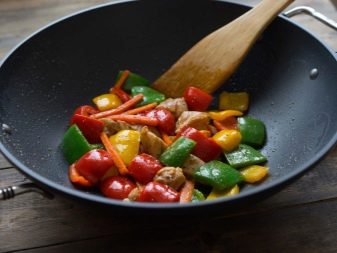
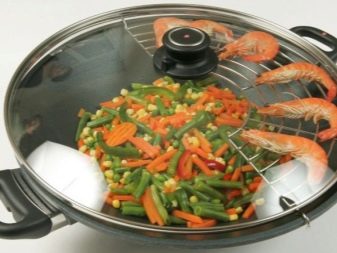
A feature of cooking in a thin-walled pan is the constant stirring. Thanks to this technology, you can use a minimum of fat or do without it at all. Frying products acquire a golden crisp, and this happens in just a few minutes. Dishes are prepared quickly, preserving the original beneficial properties, and have a special taste and aroma.
But in order to achieve this with the help of ordinary dishes, you may need a stewpan, ducklings, a double boiler, a cauldron, a pan, various pans.
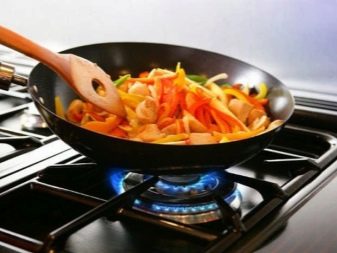
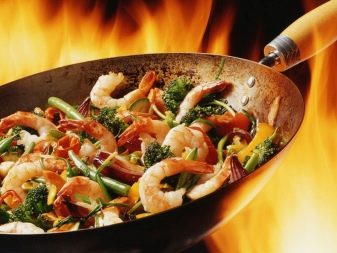
Advantages and disadvantages
Before making the final choice in favor of the purchase, once again try to determine the advantages and disadvantages of the wok. Obvious advantages:
- universality of dishes - it will replace several options for household utensils;
- time saving due to quick cooking;
- the ability to use the minimum amount of fat due to the fact that the pan quickly heats up;
- preservation of nutrients;
- fuel economy: it takes several minutes to roast, slightly to heat to extinguish;
- due to the special shape, the contents can be turned without a spatula;
- the ability to cook several dishes at once using the grill: one dish is fried (stewed), the other is steamed;
- due to the high walls, it is difficult to imagine that the dish boils away or something falls out of it when stirring;
- removable handles that save space;
- changing the shape of the bottom towards the plane made it possible to use this type of pan on electric, gas, induction stoves, and not just on an open fire.
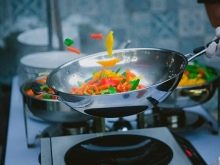
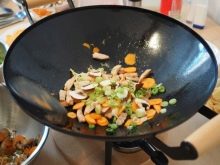
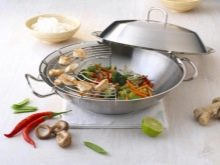
The minuses include the following points:
- metal handles - loops often cause burns, therefore it is necessary to observe elementary rules of operation;
- only wooden spatulas are suitable for use, you can not interfere with the dish with metal objects;
- wooden shovels are not always included - they need to be bought;
- a big family needs a big wok, and it may not fit in the oven.
Whether these disadvantages can be considered significant, everyone decides for himself. But the number of pluses is clearly greater.
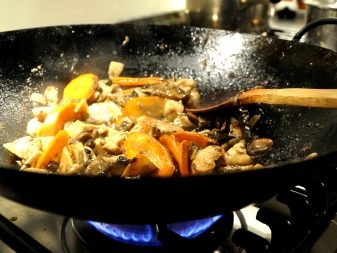
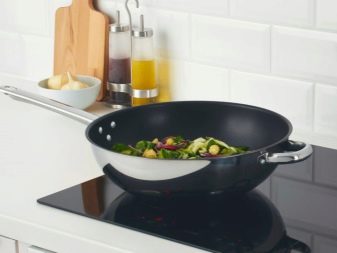
Kinds
Wok pans are distinguished by the shape of the bottom, size, volume, material, coating, type of handles, compatibility with stoves, equipment, price.
Bottom shape
In this case, the wok may be:
- traditional - for open fire, used in stoves of a special shape, suspended above a fire (barbecue) or mounted on a gas stove on a special stand;
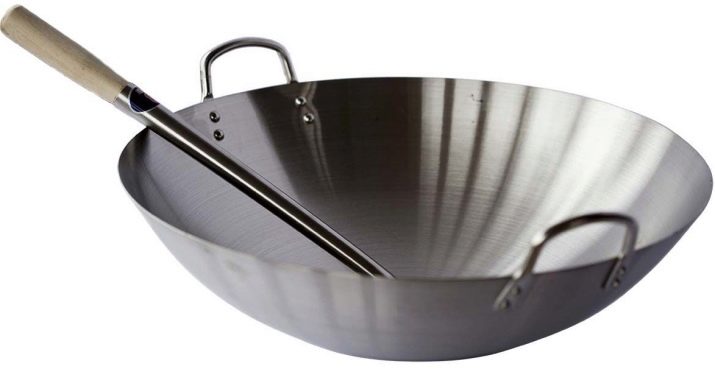
- Indian: Tamil will be of a larger diameter, a smaller pan is called karahi;
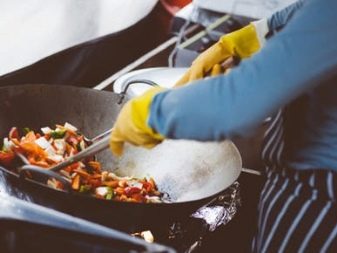
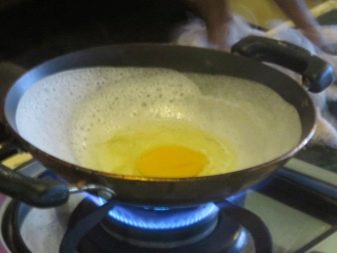
- flat-bottomed - for use on an electric or induction cooker.
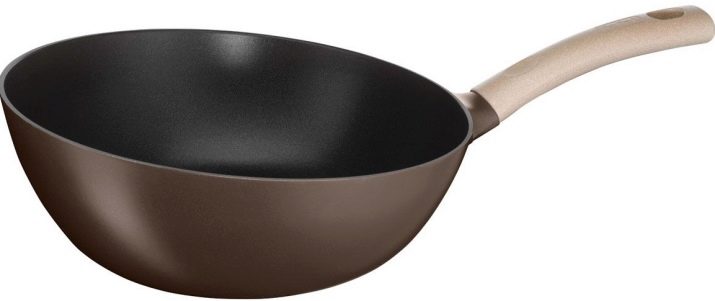
To size
When buying a pan for any type of stove, the manufacturer indicates the diameter of the upper edge, bottom and wall height. That is, on the price tag it will look like this: 40x20x6.5 cm. This cookware has a wide variety of sizes. For professional use in public catering, a wok with a diameter of 2 meters along the upper edge is used. For the countries of the East, this is normal.
In general, it all depends on the number of eaters: for 2 servings, take a pan with a diameter of 15-28 cm, for 5 servings - 30-38 cm, for 11 servings and more - 76 cm.
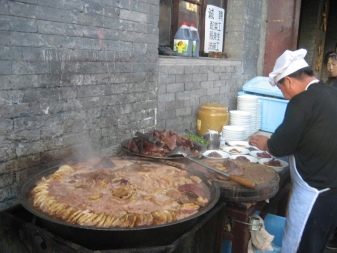
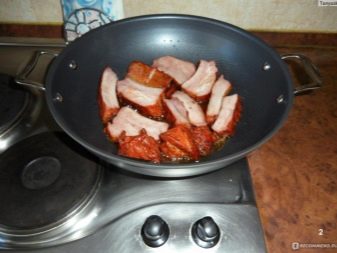
By volume
For the first and second dishes, the volume of dishes should be different, and it does not always depend only on the diameter. To a greater extent - from the height of the walls. And here the "ambush" awaits: it is still not a pan, the volume of the pan will grow along with the diameter. You can find both 1 l and 10. At a height of 9.5 cm, a wok per 10 l will be about 40 cm in diameter.
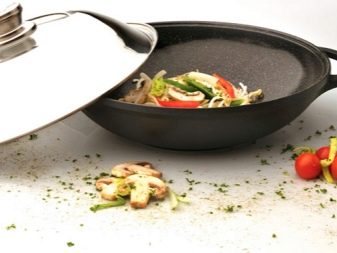
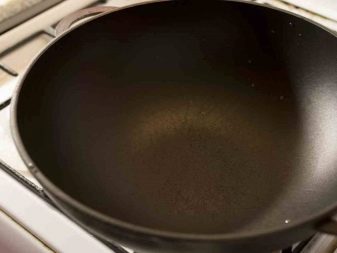
By material and plate compatibility
The metal from which the wok is cast will be of fundamental importance for technology and cooking time. Not all materials can interact with an induction or glass-ceramic stove, so when buying, you need to study the information for which stoves a particular wok is intended.
Aluminum pans heat up instantlyhave a minimum weight, but the dish without constant stirring quickly burns out. You can use such dishes on gas and electric stoves. However, a pan without a non-stick coating does not tolerate high temperatures, and even if it is coated, it wears out quickly.
Aluminum is a soft material, easily deformed. But this is an inexpensive product, it is easy to replace with a new one.
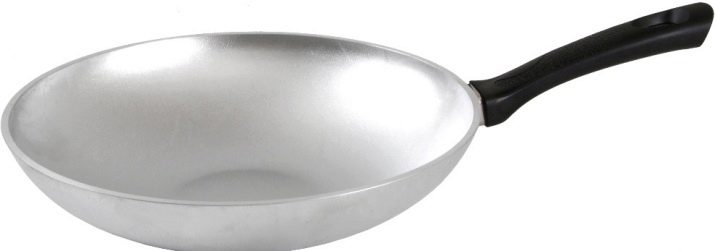
Steel woks are the most popular. But keep in mind that steel is also different. Manufacturers offer pans made of carbon or stainless steel, as well as in combination with other metals (aluminum, copper, nickel, chrome). The coverage will be of fundamental importance.
If the choice fell on uncoated dishes, then you need to know the following:
- carbon steel pans have better non-stick properties, and when using stainless steel you will have to pour more oil;
- "Carbon" woks are more suitable for frying, stainless steel - for stewing;
- if the bottom is thin, then carbon steel will soon bend, but the stainless steel does not deform;
- it is easier to care for stainless steel, dishes made of carbon material begin to rust faster;
- You can use the dishes on all types of stoves, as well as on an open fire;
- the thicker the pan, the longer it will serve;
- any steel withstands high and low temperatures;
- it is believed that dishes prepared in stainless steel retain their beneficial properties to a greater extent;
- uncoated steel utensils are inexpensive, weighs a little, it has good thermal conductivity.
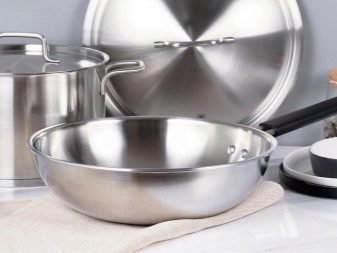

Cast-iron pan - On the one hand, these are excellent non-stick properties, and on the other hand, they are heavy and fragile. A wok with a wall thickness of 3 mm will heat up faster, but it can crack at any time. The thick-walled 9mm wok is much heavier but stronger. It will slowly heat up, but will also retain heat longer due to smooth cooling. In a thin-walled pan, it is easier to cook traditional Asian dishes by shaking. In heavy cast iron dishes, this is inconvenient.
Since dishes may rust due to water, cooked food must not be left in a cast-iron wok. In general, such dishes are easy to care for, they can be used on stoves of any type, and they are durable. But cast iron incorporates all the smells, so you need to clean the dishes thoroughly.
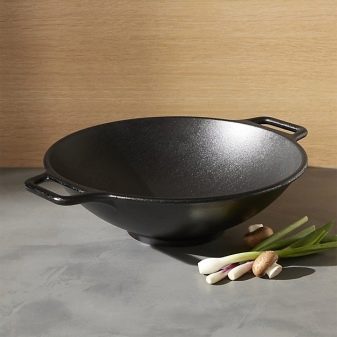
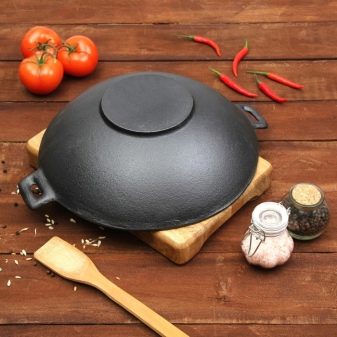
By type of coverage
Perhaps the coating is even more important than the material of the Chinese pan. It prevents the burning of food and contributes to the development of rapid mixing techniques. Consider the main types of coverage.
Granite, marble or stone
Now there are dishes with any such characteristic. In fact, all these are synonyms that indicate the application of stone chips to metal. This method allows you to give high wear resistance to the dishes. Stone chips and particles of minerals that make up these coatings turn the non-stick layer into reliable protection of the metal from scratches. Such a wok does not need oil or it is used in small quantities.
Stone coating is durable, durable, reliable. At the same time, light aluminum can be used as the material, but due to the mineral chips, the wok will store heat well.It is easy to look after this ware.

Ceramic
Ceramic-coated pans have a uniform distribution of heat over the surface and long-term retention. Ceramics are very comfortable in operation: metal blades and spoons can come into contact with it, it is not afraid of detergents. It is designed for high temperatures, but it negatively refers to the temperature difference: do not take out a hot pan to the balcony in the winter cold. The result of this treatment may be surface cracks.
Negative properties include the large weight of the dishes. And for slow stirring, like cast iron, it is not suitable. But in the dishes, which perfectly keep the heat, very tasty stewed and deep-fried dishes, Asian soups are obtained. Ceramic woks can be placed on electric and gas stoves.

Teflon
Teflon coating is the most popular. It is distinguished by resistance to aggressive detergents, high non-stick properties. But when working with such a surface, only silicone or wooden spatulas can be used.
In addition, the wok was created to work with high temperatures, and Teflon does not like this. If the protective layer is broken, harmful toxins are released.

Titanium
The titanium coating is called environmentally friendly - according to numerous studies, it does not emit substances harmful to humans. Titanium is resistant to mechanical damage, has excellent non-stick properties, will last 25 years.
That is why in cafes, restaurants and other kitchens such dishes are used as a professional. At the moment, such dishes are considered the most progressive.
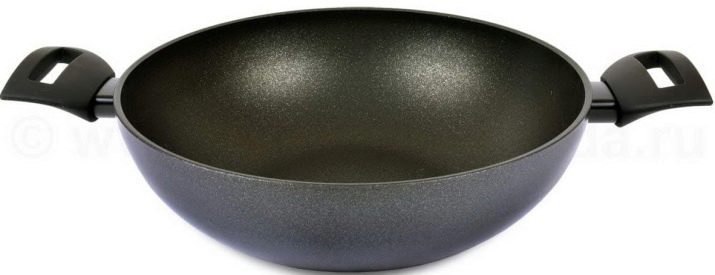
Enameled
Enameled utensils have always been valued as a means of protecting food from metal oxidation. In the manufacture of cookware for frying and stewing, glassy enamel is used, which prevents careless handling: metal brushes, shovels, spoons on such a surface should not be used. But on the enamel coating the smell of food does not linger, it is resistant to alkalis and acids, and does not interact with products. Enamel is easy to care for.
Professionals say this coating is better than stainless steel, aluminum and other metals. Enamelled wok can not be put empty on fire, and also cool under cold water or in the cold.
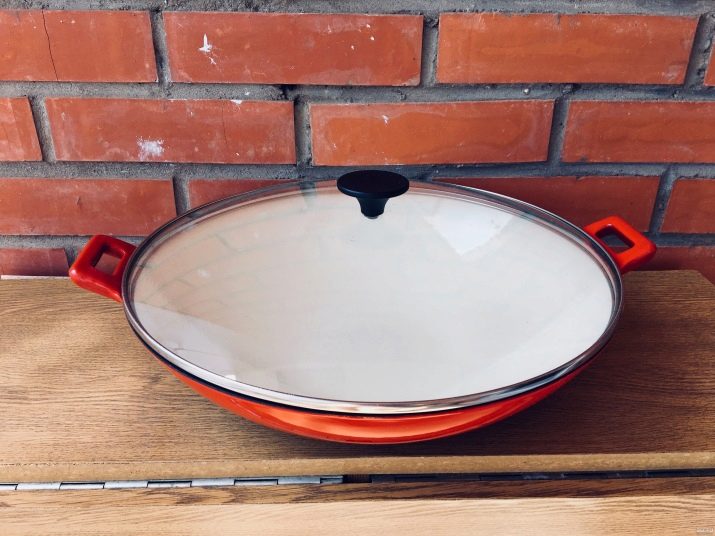
By picking
When buying a wok, you need to keep in mind that the configuration of a purchase can be very different. For quick cooking, you will definitely need a wooden spatula, spoon, slotted spoon. Chinese sticks will be useful, for some coatings - a silicone spatula. But it is advisable to buy some accessories immediately with a wok in order to choose the right size. It's about the grill and the lid.
- A special grill will occupy half of the wok. It is intended for cooking steamed dishes. At the same time, ordinary water can be poured in the pan itself or another dish can be prepared.
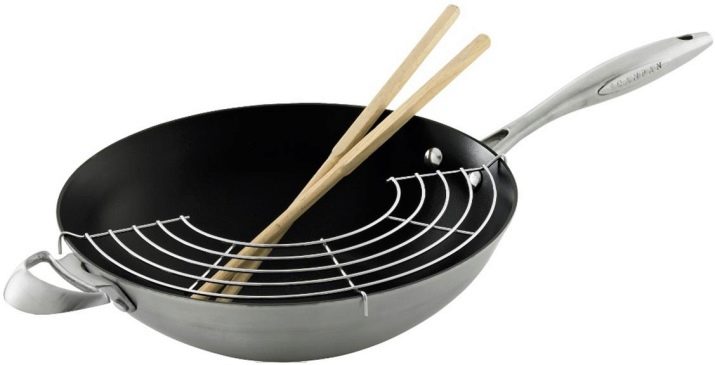
- Metal rings (wok ring) and wooden coasters to hold the classic wok on the stove and on the table - a prerequisite.
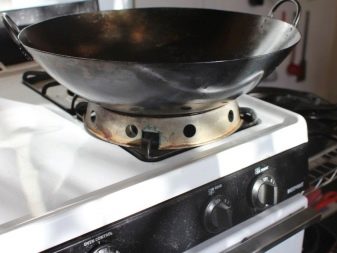
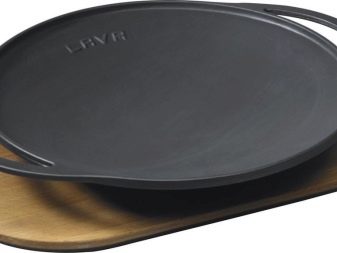
- Some buyers purchase special burner of higher power (wok burner)to comply with all the technology of cooking in a pan.

- The most important is the correctly selected cover.if it is not included. The lid can be ordinary, usually from the same material as the wok itself. But many are trying to get a pan with a vacuum lid. It is equipped with a silicone seal and a long handle, with which the lid can be placed on its side, as well as a closing indicator valve and a valve for releasing steam.
Thanks to the closing indicator, the silicone bezel fits snugly to the wok, and dishes are cooked in stewing or cooking.
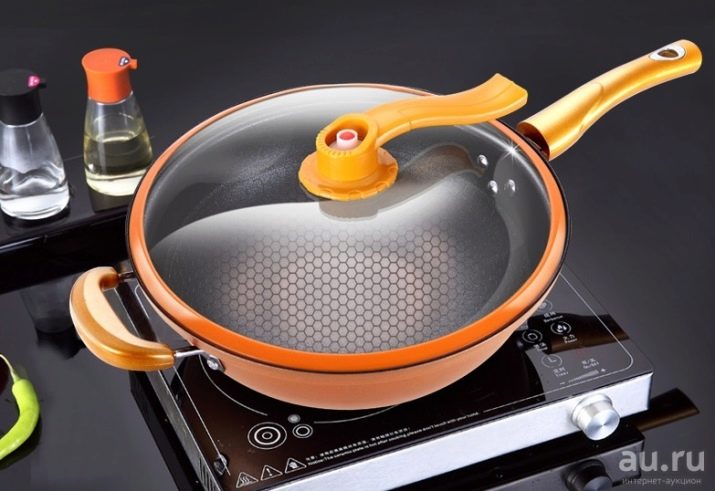
- Besides, buy bamboo steamers for wokthat are installed in the pan on a stand.Then, water is added to the metal utensils, and steamed products are laid in the bamboo tuesk. The tuyesk is covered with a bamboo lid, and the wok is covered with a metal one.
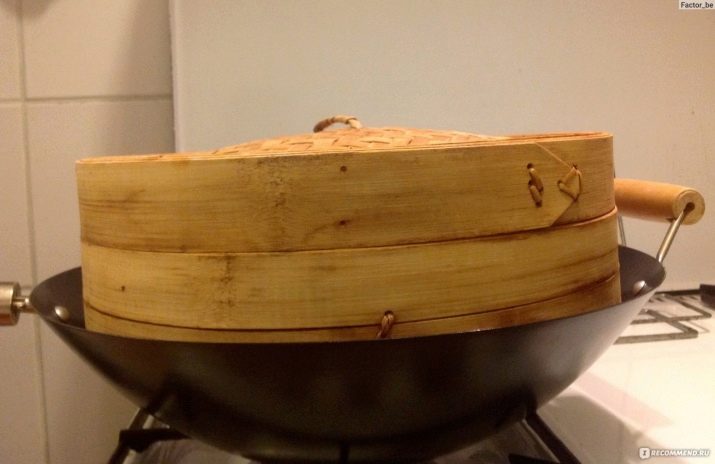
Among all types of miracle pans, an electric wok stands apart. In fact, this is a frying pan standing on an individual electric stove. This design has many advantages:
- safety of use by fixing the wok on the stand - such dishes will not move or tilt on the stove;
- more than 10 temperature conditions that make it easy to control the cooking process;
- quick heating of dishes;
- long heat retention;
- overheat protection.

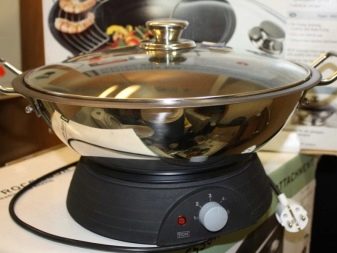
Rating models
When compiling ratings, the authors rely on a number of criteria that are important for one or another compiler. As the main criterion, we chose the material wok is made of. But often manufacturers also offer multi-layer (steel / aluminum / steel), which allows to improve the cooking properties of dishes.
Aluminum
Stahlberg Zenit 1585-S - the smallest instance, only 20 cm, with a marble coating. The volume of dishes - 1.8 liters. The obvious advantages are lightness, speed of cooking, durability, the presence of an induction disk at the bottom. The wok has a drain spout through which you can remove excess fluid. The pan can be used in the oven. The minus is the price (about 4 thousand rubles).
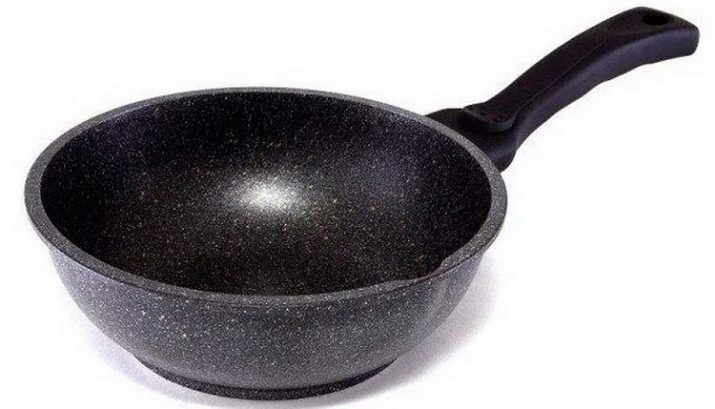
"Neva Metal Tableware", a series of "Titanium" - This is a cast pan with a four-layer polymer-ceramic non-stick coating. It has a removable handle, which allows you to use it in the oven or put in the freezer. The wok heats evenly, almost does not give in to deformation, allows strong heating and cooling. Can be placed on gas, electric and induction cookers.
Cons include washing in a dishwasher: dishes do not tolerate aggressive tablets, so you need to wash it either manually or in intensive mode without detergents.
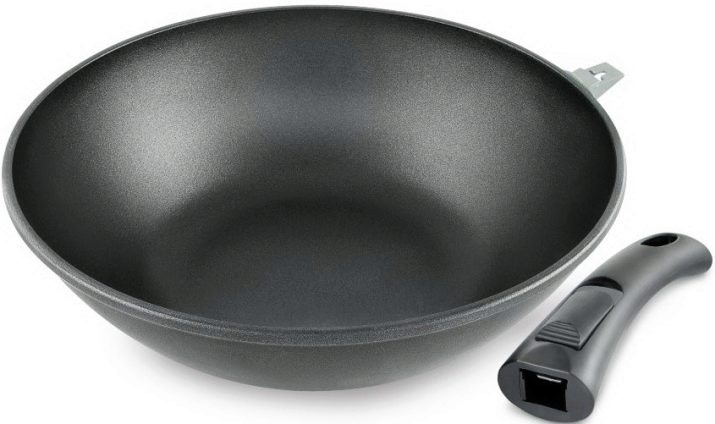
Fissman Vesuvio Stone (4247) differs in a bilateral non-stick spraying: from the external and internal sides, which makes the pan strong and durable. It is quite resistant to temperature extremes and mechanical damage. The pluses include the weight of 1 kg, an ergonomic handle, the ability to use on induction cookers, dishwasher safe, as well as a low price. The downside is the screw screw attachment of the handle.

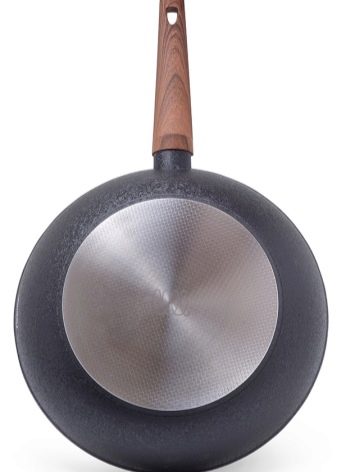
Cast iron
"Seaton Ch2680d" - This is a budget version of the Ukrainian brand, which is very popular with customers. He attracted attention with the possibility of removing the handle with a wooden trim. It is convenient to work in the technique of slow stirring and cook in deep fat. Can be placed on a gas burner and induction stove, as well as in the oven. Very comfortable price.
But this wok weighs 2.6 kg. He needs careful care, as with any cast-iron utensils. Do not wash in a dishwasher.
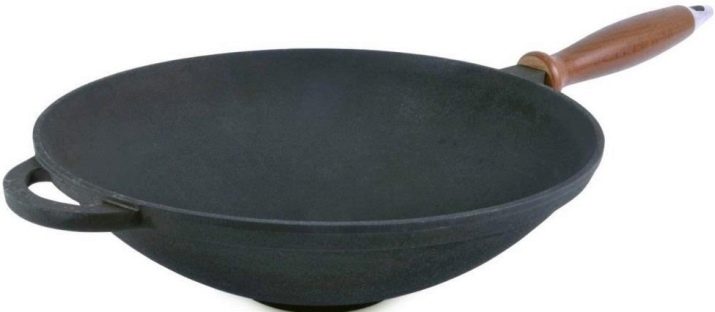
Gipfel Diletto 2147 - thick-walled compact solid cast wok with a lid. Handles are one piece with utensils. This utensil has a small diameter - 24 cm, but a good depth - 8 cm. Due to the thick walls, good warming occurs, in such dishes tasty stews are obtained. Suitable for any hob and oven. Before you start using the wok, you almost do not need to start it - it is already being processed at the enterprise. The price is quite adequate - 2.5 thousand rubles.
The disadvantages include the inability to wash in a washer and severity (2.5 kg).
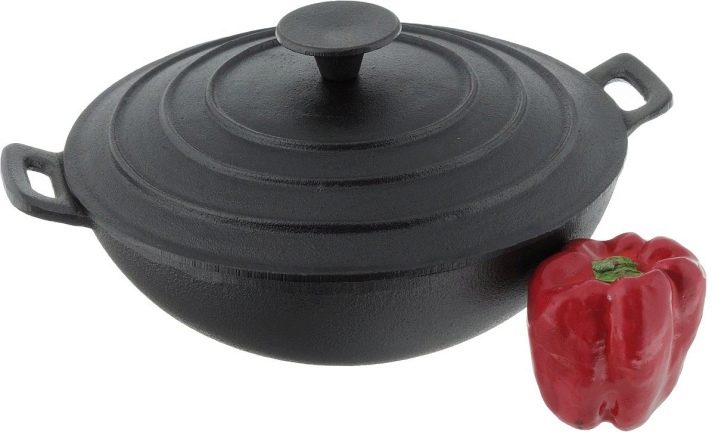
"Biol 0526C" in its properties resembles the previous instance. But in the kit, the Ukrainian manufacturer offers a heat-resistant transparent cover with a bakelite handle. Thanks to such a handle, you can safely remove the lid from the wok. The manufacturer declares that when working with this utensil, you can use metal objects. And if the pan is used without a lid, it can be put in the oven. This model is suitable for induction cookers.
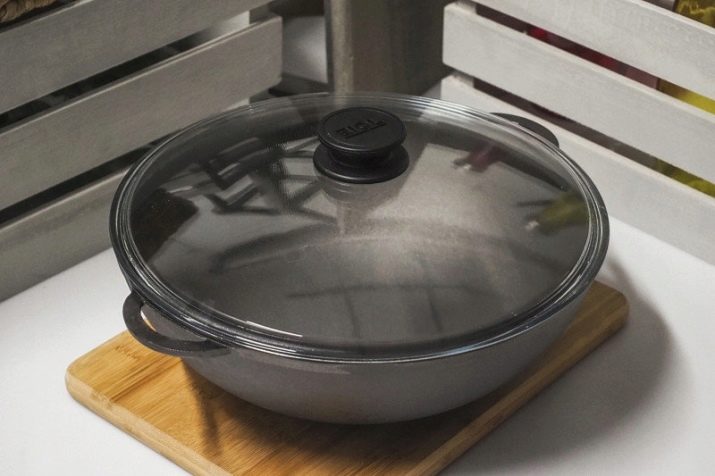
Steel
Classical Chinese woks are precisely steel dishes, most often made of high-carbon steel.
Granchio Marmo Induction (88013) - This is a big wok made of stainless steel, with looped solid cast short handles. Convenient convex lid with a glass insert allows you to cook two dishes at the same time using the grill. The pan has a non-stick coating of marble chips, which is not afraid of mechanical damage. It covers the pan from all sides. The wok heats up quickly and evenly, compatible with induction hobs.
Such dishes can only be washed by hand, and due to the considerable size, this is inconvenient to do.

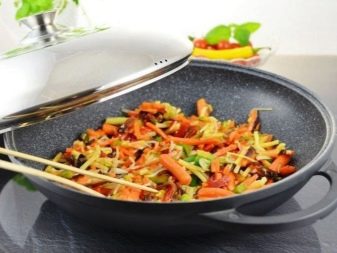
Paderno Ethnic Cuisine 49604-36 - This is a classic wok made of thin-walled carbon steel. A wooden handle, the absence of a non-stick coating, an almost hemispherical shape - this is all that is needed to prepare real oriental dishes. The dishes are lightweight, suitable for slow stirring, instantly warms up, fries meat, fish, vegetables in seconds, without draining foods. The pan has a reasonable cost - about 2 thousand rubles.
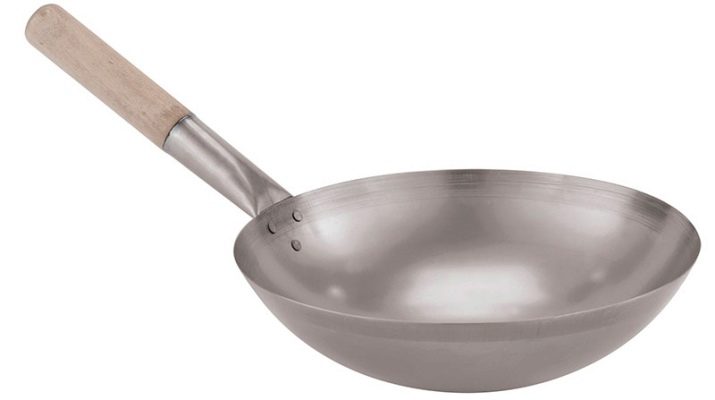
Tefal Illico (G7011914) - A popular non-stick titanium-based stainless steel model. Like most representatives of Tefal, the pan is equipped with an indicator in the form of a red circle at the bottom, by which it can be determined that the wok has warmed up to 180 degrees. The bakelite heat-resistant handle is additionally wrapped in a silicone coating with anti-slip. The weight of this model is about a kilogram. For cooking, practically no oil is required. Meat, fish, vegetables are quickly fried, preserving juice. Suitable for induction cookers. The wok is easy to wash by hand, but you can do it in a washing machine.
The disadvantages include the need for careful maintenance of the walls of the dishes, unwanted use on a gas burner, as well as the price - about 3 thousand rubles.
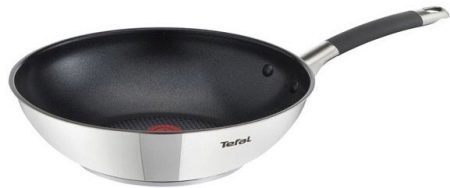
How to choose?
Absolutely all professionals will tell you that you should choose a wok depending on compatibility with the stove. Aluminum woks or ceramic coated models are compatible with gas burners and electric stoves. Models made of cast iron and steel can be put on any plates, as well as on open fire. For an induction cooker, the presence of a magnet in the material of the dishes is important, therefore, dishes made of an iron-carbon alloy are most suitable.
When choosing a material, it is important to understand that it can be thick or thin, with or without coating. Metal thinner than 4 mm is considered very thin, will not last long. Cast iron in 9 mm - very heavy, little resembles a real wok.
The shape of the bottom is another important criterion. For electric stoves, you definitely need to buy a wok with a flat bottom and high non-stick properties. Also, pans for induction and glass-ceramic plates should be flat-bottomed. But for gas stoves and burners, you can use a classic wok or a metal stand for such dishes, which is sold as a set or separately.
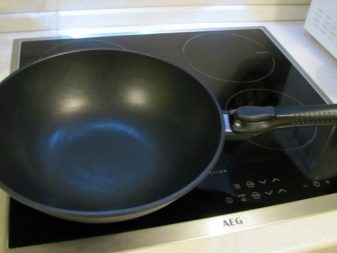
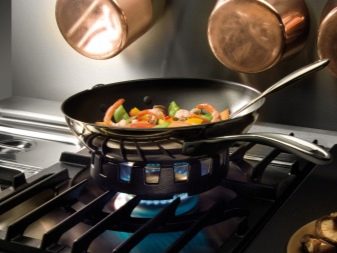
The size of the dishes should be chosen depending on:
- plates - the diameter of the bottom should not exceed the diameter of the burner;
- the number of family members;
- places of use - for home use it is not recommended to buy a pan over 30 cm - it is more difficult to handle it during cooking and more difficult to store.
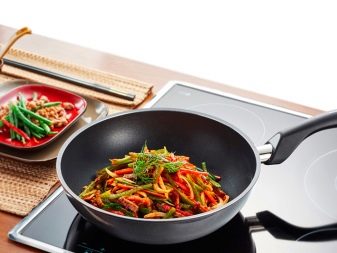

The most reliable handles are solid. But they can get very hot on an open fire or gas. In addition, such a handle will not allow you to put a wok in the oven. Therefore, many prefer removable instances. It is more convenient to have two holders for shaking. However, manufacturers offer a very good option: a long handle and a short loop. Do not forget to take care of anti-burn silicone or wooden linings.
When comparing prices, consider the presence or absence of accessories in the form of lids, grills, spatulas, skimmers, etc. Prices for woks are varied, for example, a cheap frying pan is 1.5 thousand rubles. An acceptable price is from 2.5 to 5 thousand rubles. But there are dishes for 16-20 thousand.
Thus, if a wok is purchased specifically for preparing classic oriental dishes with constant stirring technology, then the pan should be light and have a convenient handle. If the functionality is wider, then the parameters need to be set different.
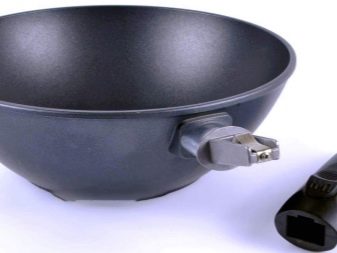
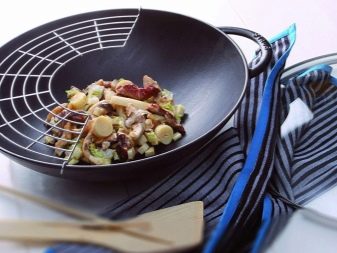
Terms of Use
Before you start using a wok, you need to prepare it for work: “open” or, as the Chinese say, hoi wok. But this applies to cast iron and steel woks. If the pan is not put into operation correctly, then all products will constantly burn. Therefore, we follow the following instructions.
- Means for washing dishes or soda to wash the purchase from the transport grease and dust.
- Remove residual detergent by boiling clean water for 5 minutes over medium heat, filling the wok as much as possible.
- After draining boiling water, check the dishes for grease using a napkin. If traces of fat are observed, then you need to rinse the wok again.
- If the preparation is done in the house, you should close the door to the kitchen, turn on the hood and open the window. If possible, the further procedure should be carried out on the street (on the grill, bonfire, in the summer kitchen).
- Dry clean wok put on maximum fire (maximum power).
- After a few minutes, the bottom will become a bluish tint due to the high temperature.
- Gently tilting the pan in different directions, you need to ignite the pan from all sides.
- When the bottom and walls become bluish, pour 80-120 ml of vegetable oil into the dishes so that the bottom is completely closed.
- Tilting from side to side, it is necessary to ensure uniform spreading of oil over the entire inner surface.
- 2-3 minutes after turning off the fire, the oil is drained and the dishes are cooled under running water: first from the outside, then from the inside.
- At maximum heat, the wok is reheated again, allowing the remaining water to evaporate.
- 30-50 ml of oil is poured into the dry pan, distributed over the entire surface and kept until smoke appears.
- The dishes are cleaned off the stove.
- Observing precautions, you need to rub hot oil into the inner and outer surfaces (paper towels or something similar).
- The wok is left on the stand until it cools completely.
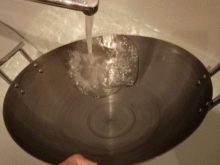

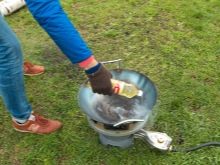
In the future, such a wok is washed with hot water without detergents so as not to destroy the oil shield. The dishes must be wiped dry with paper towels.
During cooking, too, have their own rules for operating the wok.
- Food must be constantly stirred from the center to the edges.
- The harder the product, the finer it should be cut. But all ingredients should be about the same size.
- First, heat the pan (without coating), and then the products are laid.
- Bookmarking sequence: any meat, minced carrots, onions, fleshy peppers, greens, spices, thin noodles.
- Rice or vermicelli is often boiled separately.

Reviews
A growing number of home and professional chefs are choosing wok. There are no complaints about the pan model itself. According to user reviews, this is a very convenient and functional tableware. In a classic wok it’s convenient to fry, in a cast iron - to stew and cook. Absolutely all users are happy with the wok, but they recommend carefully choosing dishes, paying attention to the material, weight, size, fastenings of handles and accessories. And then the purchase will be successful.
And the dishes in such a wonderful pan are cooked very quickly and turn out to be extremely tasty.
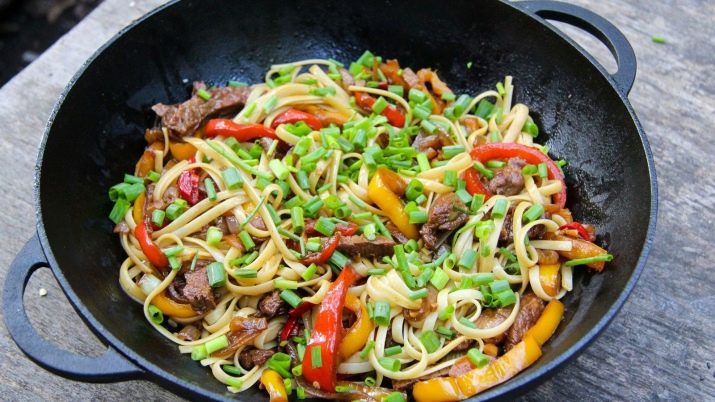
See how to cook a wok in a pan in the next video.
